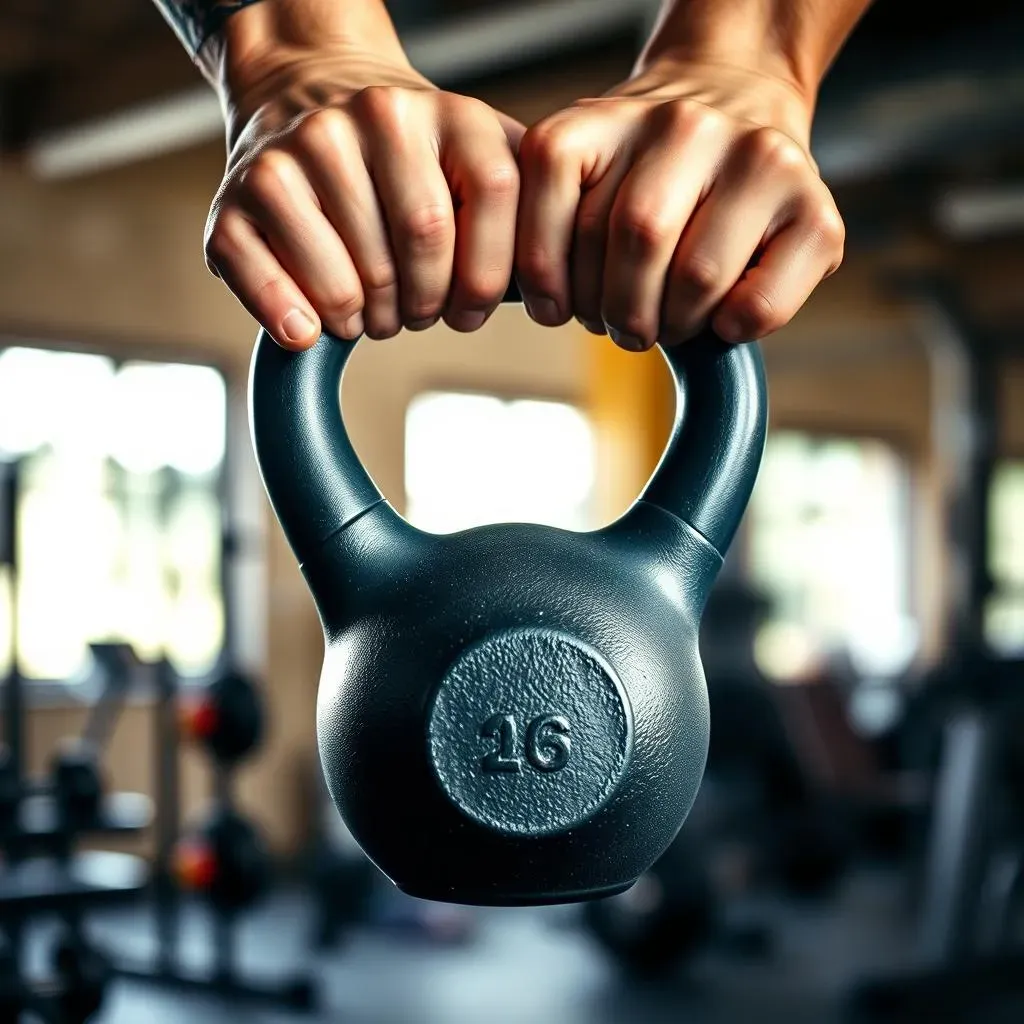Table of Contents
Ready to sculpt your dream body and shed those extra pounds? Then grab your kettlebell—this beginner kettlebell workout for weight loss is your ticket to a fitter, stronger you! Forget boring cardio; we're diving into a fun, effective, and efficient workout that'll have you seeing results in no time. This article will guide you through everything you need to know, from mastering proper kettlebell technique to choosing the right weight and building a sustainable workout routine. We'll break down a 20-minute beginner-friendly workout, perfect for beginners of any fitness level. We'll also cover essential tips for choosing the right kettlebell and show you how to progress your training as you get stronger. You'll learn how to build a workout that fits seamlessly into your life, without taking up hours at the gym. Get ready to unleash your inner strength and discover the transformative power of kettlebells! Let's get started!
Mastering Kettlebell Basics: Proper Form and Technique

Mastering Kettlebell Basics: Proper Form and Technique
The Power of the Grip
So, you're ready to dive into the world of kettlebells? Awesome! But before you start swinging that weight like a pro (or even attempting a single swing!), let's talk about the foundation of any successful kettlebell workout: your grip. A proper grip isn't just about holding on; it's about engaging your entire body and setting the stage for effective movements. Think of it as the anchor for a ship—a solid grip keeps everything stable and prevents you from capsizing (or, you know, dropping the kettlebell on your foot).
Imagine trying to build a house on a shaky foundation—it's a recipe for disaster! Similarly, a weak grip can lead to poor form, reduced power, and even injuries. So, how do you achieve that rock-solid grip? It's all about finding the sweet spot—not too tight (which can lead to fatigue and strain), and not too loose (which increases your risk of dropping the kettlebell). Experiment with different hand positions to find what feels most comfortable and secure for you. This is crucial for exercises like kettlebell swings, where a strong grip is essential for controlled movement. For more tips on kettlebell exercises, check out our 2 Kettlebell Exercises guide.
Grip Type | Description | Best For |
|---|---|---|
Overhand | Both hands grip the handle from above. | Swings, cleans |
Underhand | Both hands grip the handle from below. | Rows, deadlifts |
Mixed | One hand overhand, one underhand. | Some variations of cleans, snatches |
Body Alignment: The Key to Injury Prevention
Now, let's talk about something even more crucial than your grip: proper body alignment. This is where things get a little more technical, but trust me, it's worth the effort. Think of your body as a finely tuned machine—every part needs to work in harmony to achieve optimal performance and prevent injuries. A misaligned body is like trying to drive a car with a wonky wheel—it's not going to end well.
Proper posture involves engaging your core muscles, keeping your back straight (but not stiff!), and maintaining a neutral spine. This means avoiding excessive arching or rounding of your back, which can put unnecessary strain on your spine. For exercises like squats and deadlifts, maintaining correct posture is particularly important, as it ensures that the weight is distributed evenly, reducing the risk of injury. A beginner kettlebell program will help you learn these essential techniques.
- Engage your core muscles throughout the movement.
- Maintain a neutral spine—avoid excessive arching or rounding.
- Keep your shoulders relaxed and away from your ears.
- Look straight ahead, keeping your neck in line with your spine.
A Killer 20Minute Kettlebell Workout for Beginners

A Killer 20Minute Kettlebell Workout for Beginners
Warm-Up: Get Your Body Ready to Rumble
Before we unleash the kettlebell fury, let's prep your body. A proper warm-up is like tuning up your car before a long road trip—it prevents breakdowns (aka injuries!). We're not talking about a five-minute jog; think dynamic stretches that mimic the movements you'll be doing. Arm circles, leg swings, torso twists—get those joints moving and your muscles warmed up. Aim for 5-10 minutes of dynamic movement. Trust me, your body will thank you.
Don't skip this step! A good warm-up increases blood flow to your muscles, improves your range of motion, and decreases your risk of injury. Think of it as investing five minutes to save yourself from weeks of recovery time. For a more detailed warm-up routine, check out our guide to beginner kettlebell workouts.
- Arm circles (forward and backward)
- Leg swings (forward and backward, side to side)
- Torso twists
- High knees
- Butt kicks
The Workout: 20 Minutes to a Stronger You
Alright, let's get to the good stuff! This 20-minute workout is a circuit, meaning you'll perform each exercise one after the other with minimal rest. This keeps your heart rate elevated, maximizing calorie burn and building endurance. We'll focus on fundamental movements, ensuring you build a solid base before moving on to more advanced exercises. Remember to listen to your body; if you need a break, take one!
Each exercise will be performed for 30 seconds, followed by a 15-second rest. Complete the entire circuit three times. That's it! Simple, effective, and totally doable. You'll be surprised how quickly 20 minutes flies by when you're focused on crushing your workout. If you're looking for a shorter workout, try our 15-minute beginner kettlebell workout.
Exercise | Reps/Time | Description |
|---|---|---|
Goblet Squats | 30 seconds | Hold kettlebell close to your chest, squat down, and stand back up. |
Kettlebell Swings | 30 seconds | Hinge at hips, swing kettlebell between legs, then up to chest height. |
Kettlebell Rows | 30 seconds | Hinge at hips, row kettlebell towards chest, then lower. |
Overhead Press | 30 seconds | Hold kettlebell overhead, press straight up, then lower. |
Cool-Down: Don't Forget This Crucial Step!
You've crushed your workout—awesome! But don't just collapse on the floor. A proper cool-down is just as important as the warm-up. It helps your body gradually return to its resting state, reducing muscle soreness and preventing injury. Think of it as gently slowing down your car after a high-speed chase.
Spend 5-10 minutes doing static stretches, holding each stretch for 30 seconds. Focus on the muscles you worked during the workout, like your legs, arms, and core. This helps improve flexibility, increase blood flow, and promotes recovery. For more cool-down ideas, check out our beginner kettlebell program which includes detailed warm-up and cool-down routines.
- Quadriceps stretch
- Hamstring stretch
- Calf stretch
- Triceps stretch
- Biceps stretch
Choosing Your Kettlebell: Weight, Type, and Where to Buy

Choosing Your Kettlebell: Weight, Type, and Where to Buy
Finding the Right Weight: Not Too Heavy, Not Too Light
Picking the perfect kettlebell weight is crucial. Too heavy, and you risk injury and poor form. Too light, and you won't get the workout you need. Think of it like choosing a bike—a bike too big is hard to control, and one too small doesn't give you a good workout! Start light. Seriously. It's better to build up gradually than to hurt yourself on day one. Aim for a weight you can comfortably handle while maintaining good form. If you can't maintain good form, you need a lighter weight.
For most beginners, a 10-12kg kettlebell is a great starting point. Remember, you can always increase the weight as you get stronger. Don't rush it. Focus on quality over quantity—perfect form with a lighter weight is far better than sloppy form with a heavier one. For more guidance, check out our beginner kettlebell workout guide for detailed tips on selecting the right weight for your fitness level.
Gender | Suggested Starting Weight (kg) | Suggested Starting Weight (lbs) |
|---|---|---|
Female | 8-12 | 17-26 |
Male | 12-16 | 26-35 |
Kettlebell Types: Exploring Your Options
Did you know there are different types of kettlebells? Yep! It's not just about the weight; the type of kettlebell can also impact your workout. The most common types are cast iron, vinyl coated, and competition kettlebells. Cast iron kettlebells are durable and affordable, but they can be rough on your floors. Vinyl-coated kettlebells are gentler on surfaces, but they might not last as long. Competition kettlebells are designed for competitive lifting and are typically more expensive.
For beginners, a cast iron or vinyl-coated kettlebell is perfectly fine. Don't get bogged down in the details; focus on finding a kettlebell that feels comfortable in your hand and allows you to maintain good form. A good quality kettlebell is an investment in your fitness journey. For more kettlebell exercises, check out our 4 best kettlebell exercises guide.
- Cast iron: Durable, affordable, can be heavy.
- Vinyl coated: Protects floors, may not be as durable.
- Competition: Smooth, precise, more expensive.
Beyond the Basics: Progressing Your Kettlebell Journey

Beyond the Basics: Progressing Your Kettlebell Journey
Beyond the Beginner: Level Up Your Kettlebell Game
So you've conquered the beginner routine? Fantastic! Now it's time to push your limits and take your kettlebell workouts to the next level. Think of it like leveling up in a video game—you've mastered the basics, now it's time for more challenging quests! This means gradually increasing the weight, incorporating more complex exercises, and experimenting with different workout structures. Remember, consistency is key—even small improvements add up over time.
One great way to progress is by increasing the duration of your workouts, adding more sets or reps of each exercise. You can also start incorporating more advanced kettlebell exercises, like Turkish get-ups, snatches, or cleans. But remember, always prioritize proper form over speed or weight. A solid foundation in technique will prevent injuries and allow you to progress safely and effectively. For inspiration, explore our advanced routines in our ultimate kettlebell workout for beginners guide.
- Gradually increase the weight of your kettlebell.
- Add more sets or reps to your existing exercises.
- Incorporate more advanced kettlebell exercises.
- Experiment with different workout structures (e.g., supersets, drop sets).
Workout Variations: Spice Up Your Routine
To avoid hitting a plateau, it's essential to keep your workouts fresh and challenging. Think of your workout routine as a delicious meal—you don't want to eat the same thing every day, right? Varying your exercises keeps your muscles guessing and prevents boredom. This also helps prevent your body from adapting too quickly to your routine, which can hinder progress.
Experiment with different exercise combinations and workout structures. Try supersets (performing two exercises back-to-back with minimal rest), circuit training (performing multiple exercises in a continuous loop), or pyramid training (gradually increasing or decreasing the weight or reps). You can even incorporate kettlebell exercises into other forms of training, such as HIIT or strength training. For more HIIT ideas, check out our kettlebell HIIT workout for beginners.
Workout Structure | Description |
|---|---|
Supersets | Perform two exercises back-to-back with minimal rest. |
Circuit Training | Perform multiple exercises in a continuous loop. |
Pyramid Training | Gradually increase or decrease weight/reps. |